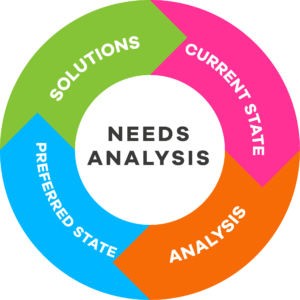With a needs analysis you understand your customers better

Do you understand your customers needs? With a model for needs analysis you’ll get a clearer picture of their issues and challenges. A great needs analysis also increases the customers understanding of their own situation, which will make it easier for you both to find solutions to their problems.
It should be a given that a needs analysis ought to be the basic for understanding your customers. Even if you’re not actively working with customer needs analysis today, there’s usually traces of analysis in your calls to your customers. Does it feel a bit unclear? Let us explain!
What is customer needs analysis?
A needs analysis is used to understand what a customer truly needs. It’s about finding the customer value of your solutions to their needs and challenges.
A customer needs analysis will give you a picture of the current state of things and what’s needed to take the next step in the process with the customer. You get this understanding by asking the right kind of questions, it’s that simple!
The circle is closed: A model for needs analysis

With a model for customer needs analysis, you’ll be able to have a well-thought-out strategy in place for your calls and communication with your customers. Depending on the product or the services you’re selling you might need to do the needs analysis before the first call or over a longer period.
The common denominator for all needs analysis models is that they’re all circular, all the touch points return over time. It goes like this: In the time that you’ve identified, handled and solved your customers needs, new ones will arise. Salespeople that are good at customer needs analysis use this knowledge to do additional sales in the long run. A good memory and clear documentation in your CRM-system is the key for long-term success.
What would a model for needs analysis look like?
Start with identifying the current state of things: Where are we today? Once that question has been answered the follow-up question is: Why does it look like this? What obstacles and opportunities exists? You can use the needs analysis as a bridge between the current state of things vs where the customer wants to be. If you listen carefully to your customer, you’ll have an idea of what they need and why they need it, and you’ll be able to present them with a solution to their issues that moves them in the right direction.
Questions that gives you the answers to customers needs
A wise person once said: “There are no stupid questions”. There might not be stupid questions, but there are questions that will lead your sales call in the right or wrong direction. Here are some examples of questions that can be used for customer needs analysis in B2B-sales.

Direct questions
A direct question means that you’ll be able to get two answers: Yes or No. There are always some people who won’t respond to a direct question and give you a semi-answer, for these types of personalities you can use other alternatives instead (read further down). Here are some examples of direct questions:
“Are you satisfied with your current subscription?”
“Do you get quick service when you contact our support?”
“Would you like to lower your cost by 10 percent?”

Open questions
On the opposite side of direct questions lies open questions. The goal of an open question is to get longer, more detailed answers from the customer explaining their situation. The drawback of an open question is that the customer can take control over the conversation and steer it in another direction. Stay on target for the call, and don’t be afraid to interrupt the customer with follow-up questions if you feel like the customer is taking over the call.
“How would you like your handling of quotes to work?”
“Why is it hard to have your salesperson document all their calls?”
“What measures are most important for you in the next 6 months?”

Leading questions
A leading question invites a desired response. By using something the customer has already talked about, you can continue with a leading question. You can for instance confirm the customers point of view or need with a leading question. The purpose of a leading question is to lead the call forward towards your end-goal.
“Has it been hard to engage management in this question?”
“Is it hard to motivate the cost of your current solution?”
“Are you responsible for updating your old accounts now?”

Follow-up questions
Follow-up questions tests or challenge the customers previous answer or experience. They can be used to keep the conversation alive or to expand on the customers experience with a topic.
“What do you mean by that?”
“How did you come up with that?”

Tie-down question
The purpose of a tie-down question is to get the customer to accept a deal or a temporary solution. You present the solution you’ve talked about and ask the customer if it’s something they’re able to sign up for.
“If I can deliver the installation next week, would you be able to get a signature on the contract by Friday?”
”If we can go down on price to the desired level, are you willing to close the deal?”

Alternative questions or A/B-questions
If you want a quick response from the customer alternative questions are ideal. A great place to use alternative questions would be when you’re cold calling to book a meeting. They’ll usually come back with an answer 9 times out of 10 to a A/B-question.
“Are you able to have a meeting on Tuesday at 10.00 or would Wednesday at 15.00 work better?”
”Does the end of the week work for you or should we meet next week instead?”
”Do you like the red or green better?”
Example on needs analysis and how it wins the customer – step by step
1. Identify the current state of things
Time to pick up the phone and make a call! The first step is to identify the current state of things at the customer. Depending on how your customer prefers to communicate you’ll be able to ask open, direct or leading questions. Don’t let the customer take control of the call, lead it in the direction that gives you the answers you need (Be prepared with questions!).
2. Analyze the current situation
When you think you have a handle on the current state of things at the customer it’s time for part two, the analysis. The best way to analyze the customers situation is to ask follow-up questions. Repeat what the customer has already told you, but with the question:
– If you experience [challenge], would it help if you had access to [suggestion]?
Present concrete examples and solutions to the customers challenges and listen carefully to their reaction. Is the solution too far away from the customers idea of what’s possible?
3. Identify a preferred state
The analysis of the current state should lead you into a preferred state. Sure, you could just ask the customer “How would you like things to be?”, but a vast variety of research shows that people don’t know what they want. This is the time to show the customer a vision of the future, sort of like a bridge between the current and preferred state of things.
4. Build a bridge between current and preferred state if things
Sometimes the mental distance feels bigger than it is. Remember that the customer doesn’t always see the end vision as clearly as you do. You might know that your solution works, but to have the customer onboard you need to build a bridge between current and future state of things.
You can construct this mental bridge simply by 1) repeating what the customer said was their challenge, with 2) providing the solution as a question. If you do it the right way the customer will feel like they’re finding the answer themselves (even if you helped build the mental bridge that helped them find the answer).
5. What does it take for the solution to be a reality?
The mental bridge has been built, now you just need to agree about how to make the solution a reality. What does it take for the customer to reach the preferred state of things? It could be for instance:
- Budget
- Resources like for instance staff
- Technical solutions
- Deadlines for the project
6. Present your solution
Now we’re at the bottom line of the customer needs analysis. You know where the customer currently is, what their needs are and where they want to be in the future. You’ve also covered what they would need to do for the change to happen.
Hopefully you and the customer are on the same page by now. You have a plan that will move them to the preferred state and you know exactly what it takes to succeed. It’s time to present your solution and see what their reaction will be.
With a thorough needs analysis of your customers company and their needs you’ll have the best possible outcome for success with your salespitch. By using a CRM-system you’ll be able to take notes and reminders about important conversations you’ve had with the customer while doing the analysis, and have instant access to it when you need it to close the deal!
Do you want to learn more about Lime CRM and how you can use it for your needs analysis?
What are you waiting for?
There’s no time to waste! Let’s find the solution that will help you get more customers and turn existing ones into loyal ambassadors today.